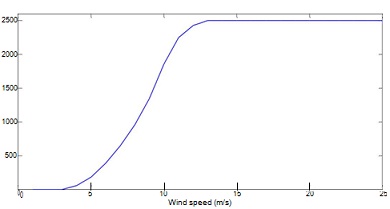Assignment: Energy and Climate: Vision for the Future, Spring
Part 1:
Choose a news or journal article relating to climate or energy that has caught your recent attention. Summarize the main points of the article and your reaction in one well-written paragraph (100-200 words). Include a citation for the article.
Part 2: Quantitative problems.
1) Energy from different fuels.
A 500 MW generating coal fired power plant can produce 2,460 kWh of electricity from 1 metric ton of coal.
a) If the plant is running at full capacity for one week, what is the electricity output in kWh?
b) How much coal (in metric tons) is required to produce this electricity?
c) If one metric ton of 235U produces 8.76 x109 kWh, how much 235U (in kg) is needed to produce the same energy as the coal fired power plant for one week?
2) Wind Energy.
The standard power curve (power output from a wind turbine as a function of wind speed) of the GE 2.5 MW wind turbine is show below.

a) If the annual average capacity factor of a given wind turbine is 30%, what is the annual average power output (in MW) for the wind turbine?
b) What is the corresponding wind speed (m/s) for the average wind power output?
3) Solar Energy.
A university uses 100 kWh per building per day. They aim to meet 30% of this need using solar energy. The university owns 155 buildings; of these, they have 75 buildings with south-facing roofs on which solar panels can be installed. The average area of the south-facing portion of these roofs is 50 m2. Assume that, on average, a 1 m2 solar panel produces 1 kWh per day. Can the university meet their aim? Show all of your work and intermediate answers.
Part 3: Conceptual questions
Short Answer:
4) For electricity generation, 235U needs to be enriched to about ______%. For weaponization, 235U must be enriched to about ______%.
Multiple Choice questions :
5) The most abundant form of naturally existing uranium is:
a) 234U
b) 235U
c) 236U
d) 238U
6) The process of increasing the amount of 235U in a given sample of uranium is called:
a) enrichment
b) isotopic collection
c) linear filtration
d) diffusional collection
7) Submerging the control rod into the nuclear reactor will:
a) speed up uranium fission
b) convert 235U to 238U
c) slow down uranium fission
d) convert free neutrons to electrons
8) The maximum efficiency for wind power is known as the:
a) Wind Capacity Factor
b) Turbine Maximum
c) Rotational Efficiency
d) Betz Limit
9) How much does wind power contribute to total electrical energy production in the US?
a) 0.1%
b) 6%
c) 12%
d) 28%
10) Which region of the US has the highest potential for solar power?
a) Northeast
b) Southeast
c) Northwest
d) Southwest
11) Electricity from solar panels produced _________ current.
a) negative
b) positive
c) direct
d) alternating
Question: CCS (carbon capture and storage) entails capturing CO2 before it can be emitted into the atmosphere. This captured carbon then has to be stored in a location that prevents release into the atmosphere. Where are some locations that are proposed for carbon storage?